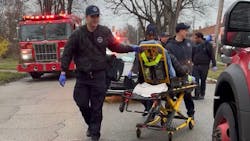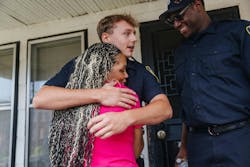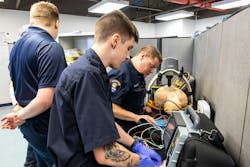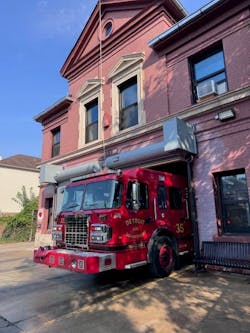Detroit Fire Department 165th Anniversary: A Case Study in Improved Operations, Morale & Community Service
Key Takeaways
- The filing of Chapter 9 bankruptcy by the city of Detroit served as a springboard to improvements that the Detroit Fire Department implemented and has on the drawing board.
- More than 10 minutes has been shaved from what once was an average 18–20-minute response to Code 1 medical calls as a result of the Detroit Fire Department’s implementation of its Medical First Responder program.
- Having achieved an ISO 2 rating, the Detroit Fire Department has its sights set on an ISO 1 rating, with a proposal to build 10 new stations in the next 10 years contributing to the effort.
Note: This article is part of Firehouse's Detroit Fire Department 165th Anniversary Special Section. To read the entire Special Section, click here.
On July 18, 2013, the city of Detroit filed for Chapter 9 bankruptcy. Contributing factors were the city’s debt load, a weakening tax base, high unemployment and increasing costs for retiree benefits. Unsurprisingly, the city’s situation affected the Detroit Fire Department (DFD). Apparatus operating past their life expectancy was common. Membership morale was low. Response times for medical calls were long.
The city exited bankruptcy in December 2014, and following that, balanced budgets and strong cash surpluses became the norm. The DFD benefited. Its operations have turned a full 180 degrees from where they were in 2013. In the past two years alone, the department’s budget went up some $40 million total. Once perceived as an agency that was broken, the DFD now is a healthy organization that’s looking to achieve great things in the next years and decades of the century.
“The five to eight years leading up to bankruptcy, every day was just crazy,” Battalion Chief Eric Fett tells Firehouse. “To turn the ship around the way that we did in such a short period of time speaks volumes of the dedication, the love and the respect that the men and women who work for the department have for the city.”
Commitment to community
The morale of the members of the DFD might be at an all-time high, and word is getting around. Although the department garnered interest for years from firefighters outside of the city for the opportunity to fight fires multiple times per week (even daily), attention today is strong despite the significant reduction of fires that results from the city’s removal of vacant buildings. The department’s efficient and effective operation (including from the influx of technology for the fireground and administratively), its continuing upgrade of apparatus and equipment, and its dedication to training finds the DFD in the enviable position of turning away hundreds of applicants every recruiting period.
“During my first 20 years with the department, I never worked with anybody from outside of the city or the surrounding community,” Fett says. “Today, we have members from all over.”
Contributing to this is the department’s 2015 decision to implement its Medical First Responder (MFR) program for all DFD firefighters. The goal: Train members to be able to provide initial basic medical care to Code 1 response victims until a medic unit arrived. (Editor’s Note: Nationally, this translates to high-priority, or echo, compared with low-priority, or alpha.) There was some resistance from veteran members, but that was short-lived. Further, the program appealed to many younger members, not to mention potential applicants.
“Younger people are sponges,” Battalion Chief Sam Vazquez believes, and when broadening members’ worth is obvious, the appeal of the department increases.
Executive Fire Commissioner Chuck Simms tells Firehouse that Code 1 responses in the 2013 time frame hovered around 18–20 minutes.
Today, 1,185 DFD members have a medical certification; 765 firefighters are EMTs; 130 are paramedics, with another 30 members currently in the DFD’s own paramedic training program, which it started in January 2025. EMTs have a direct, 12-lead connection with hospital staff, which permits the EMTs to send cardiac data while on scene or while en route.
In 2024, Code 1 response times for the DFD averaged 7 minutes, 30 seconds from the time a resident calls 9-1-1 to when the first-arriving company is on scene.
“That’s one of the best in the country,” Simms says, “and we’re looking to decrease it even more.”
MFR was part of the contract negotiated during the bankruptcy period between the newly appointed emergency manager, the DFD and the Detroit Fire Fighters Association.
“[The union] had some issues that it pushed, but for the most part, it recognized the value of an MFR program,” Fett recalls.
“I believe that the change would have happened as the younger generation came in, but by being in bankruptcy, the change was able to occur quickly,” Fett adds.
Simms doesn’t want to imply that implementation of MFR wasn’t without its challenges.
“To transition to respond to medical runs was a culture shock,” he concedes. “Getting the members to buy into it was perhaps the biggest challenge.”
Part of that was helping firefighters learn how to interact with citizens.
“To actually go and talk to people and to care for people is a huge matter if you never had to do that,” Simms says. That can be particularly difficult when members don’t see the commonalities between themselves and the public. He explains that element was key to the nonmedical facet of MFR.
Ambulances & apparatus
Included in the effort to further reduce Code 1 and other EMS response times is the addition of more ambulances.
Given the difficult financial circumstances that the department faced prior to the city’s bankruptcy filing, funding wasn’t available to address a shortage of ambulances and personnel to staff them.
“In 2013, if we deployed 18 ambulances in service on any given day, it was a good day,” Simms says. That included support from private ambulances companies, but the department didn’t have the money to collaborate with those agencies to a significant extent.
Today, the DFD has contracts that provide for 16 private ambulances to be supplied per day, and the department now has 26 of its own medic units on the street every day. Ten of those are recent deliveries, and 10 more likely will be delivered by the end of 2025.
In addition, 10 new pumpers were delivered in the months leading up to the publication of this article.
The new apparatus figure into the DFD’s work to achieve an ISO 1 designation.
“To get these 10 fire apparatus will put us back on pace as far as reserve vehicles,” Simms notes. “Creating reserve rigs is part of the [ISO] scoring,” Second Deputy Commissioner Derek Hillman explains, “and it was important to standardize our fleet across the board so that our reserve rigs could be utilized in a quicker fashion.”
Stations
Another factor in play in the effort to increase the ISO rating is stations. During bankruptcy, some companies were shut down.
“We’re looking at building new stations to clean up some of our holes within our coverage,” Hillman tells Firehouse, “because we’re sitting on a 100-year-old footprint.”
“We have a deployment plan that we’re going to present to the city council,” Simms adds. “It’s focused on building 20 new fire stations over the next 10 years and placing them strategically throughout the city to help decrease our response times and to stay in line with NFPA and ISO standards.”
That isn’t to say that the DFD’s fire response times have been troublesome. Simms is proud of the department’s historical sub-6-minute response to fires.
The design of new stations will include drive-through apparatus bays and reduced carbon footprints, including via the use of solar power.
“Right now, I believe that we’re paying $3 per square foot for maintenance,” Simms says. “A new station would decrease that to $1 per square foot.”
A bright future
When Mayor Mike Duggan took office in 2014, a key aim of his was to modernize the city, including via the adoption of technology systems. Some of those pertained to the DFD. Digitization allowed the department to identify gaps. Data helped immensely in the effort to pinpoint where improvement was required and how to achieve that improvement.
“It’s culture, trust and staffing,” Simms says in summary. “Our members are able to provide higher level of care, and that builds back up the trust among the public. And the reputation of the department no longer is one of being broken but of one that is looking to move ahead into the next century.”
What a difference 10 years make.
About the Author
Rich Dzierwa
Managing Editor, Firehouse Magazine
Rich Dzierwa joined Firehouse Magazine in 2019 after four tenures with other publications. He was editor-in-chief of Consumers Digest/ConsumersDigest.com and of trade magazine Cutting Tool Engineering. He served as the consumer products reporter for BridgeNews and began his publishing career with an 11-year tenure at Appliance magazine, where he rose to managing editor after serving in other roles. Dzierwa's experience with consumer products, including furnishings, appliances, electronics and space design, has transferred to his Firehouse work regarding the magazine's Station Design columns and the Station Design Awards. Previous work also has contributed to his supervision of several surveys of fire service/EMS members, to produce unique reporting for Firehouse's audience. Dzierwa earned a bachelor's degree in English from Columbia College Chicago.




